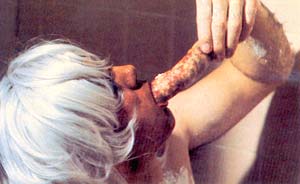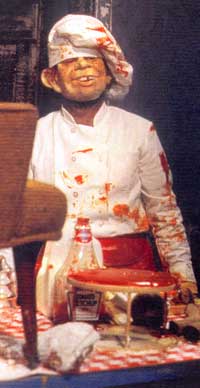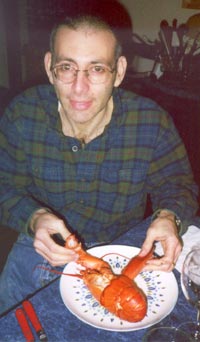
|
Jacket 15 — December 2001 | # 15 Contents
| Homepage | Catalog | |
Shine a Dark Light on It:Alan Gilbert reviewsA Knot Is Not a Tangle by Benjamin FriedlanderSan Francisco: Krupskaya, 2000. ISBN 1-928650-06-6, USD$9Available from Small Press Distribution at http://www.spdbooks.org/ This piece is 2,500 words or about five printed pages long. |
|
ONE OF THE MORE PROMINENT TRENDS in visual art during the past decade has been the rise — or is it return? — of abject art. It’s a style that’s even received institutional sanctioning, as in the example of Kiki Smith’s sculpture Tale (1992), a flesh-colored life-size figure of a woman down on all fours with what looks to be a nearly ten-foot long brown trail of feces coming out of her anus. The somewhat ambiguous nature of the scene reflects back, in turn, on the punning title: Is the brown appendage a tail, a trail of shit, a tale pointing to the stress language undergoes at the borders of abjection and transgression? The inclusion of Tale in the second part of the Whitney Museum of American Art’s massive exhibition The American Century: Art and Culture 1900-2000 helped make it one of the more iconographic art images of the ’90s.
Or take Paul McCarthy’s recent retrospective at the New Museum of Contemporary Art, which includes videos of early performances such as Tubbing (1975), in which McCarthy, wearing women’s makeup and a blond wig, smears himself with cold cream and ketchup before shoving a raw sausage down his throat; or Rocky (1976), in which McCarthy, wearing only boxing gloves and an old-fashioned burglar’s mask, plays with his penis before punching himself silly, decades before the masochistic masculinity and pseudo-critique of media culture in the film Fight Club. |

Paul McCarthy, Tubbing
|
|
(If Brad Pitt wants to keep pushing the envelope of his public body image along the lines of his provocative photo shoot with Steven Klein in the July 1999 issue of W, maybe he should consider reprising McCarthy’s — viz., not Stallone’s — Rocky.) After taking time off from performing in the late ’80s, McCarthy returned with more high-end pieces such as Bossy Burger (1991), in which he dons a chef’s hat and uniform, red over-sized clown shoes, and an Alfred E. Neuman mask, and proceeds to create an incredible mess of himself and an old stage set from the ’60s TV show Family Affair with barbecue sauce, ketchup, mayonnaise, milk, flour, and his own saliva. |
 Paul McCarthy, Bossy Burger
|
|
Within this art-historical context, it’s almost too easy to say that abjection represents a return of transgressive subjectivity as the repressed. After all, one person’s repression can be another person’s liberation, and vice versa. The more difficult questions are: How did it get repressed in the first place? Who — or what — repressed it? It’s sometimes difficult to remember that the attack on the integrated human subject that became such a central doctrine of postmodernism and poststructuralism was originally rooted in the critique of a European + male + universalist + humanist subjectivity, not subjectivity in general. For many people — actually, for much of the population — establishing one’s position as a viable political and social subject can still be a precarious situation. As the notion of de-centering became less a mode of critical analysis, and more an unexamined theoretical buzzword and formulaic set of artistic and literary techniques, this crucial awareness was lost in the enthusiasm over art and texts that purported to destabilize subjectivity in all its forms. |
 Ben Friedlander |
|
Many of these elements — abjection, repetition, disfiguration — appear in Benjamin Friedlander’s recent book of poems A Knot Is Not a Tangle, though the work shouldn’t be read exclusively in relation to these ideas, because it also exhibits a strong indebtedness to conceptual art. And while the return of the repressed in Friedlander’s poetry partakes in these larger art world and historical phenomena, the most immediate aesthetic context for his work’s engagement with questions of subjectivity is the wholesale assault on stable subject positions made by the poets and critics associated with the Language Poetry movement — and its sometimes intellectually sloppy equation of these subject positions with the oh-so-dreaded “lyric I.” As in the work of visual artists such as McCarthy, Smith, Mike Kelley, Kara Walker, etc., the subject in Friedlander’s poetry returns from its relegation to the personal and collective unconscious with less conventionally acceptable sets of concerns. Junky vets
Besides describing the “tracks” tears make on a face (referenced non-ironically — imagine that!), the title references the “tracks” on a junky’s arm, as well as horseracing tracks. Moreover, the references to the Holocaust in other parts of the book here conjure an image of the “tracks” on which the trains ran that transported Jews to Nazi concentration camps. Like an infant beauty queen
As in this poem, the words that appear to be left out in Friedlander’s series of “unfinished” poems are the abstract nouns and proper names with which rationality is usually associated. The murder of Jon Benet Ramsey, the police investigation of it, and the subsequent media coverage strain the capacities of rationality to comprehend what occurred, or to separate the actual event from media representations of it. “The pure products of America / go crazy — “ writes William Carlos Williams in Spring and All; though in Friedlander’s poem (as in McCarthy’s art), nothing is pure, and every experience and understanding has already been mediated, i.e., the insanity comes from within the house. Written in Yellow Some of the more important questions raised by this poem, and raised by A Knot Is Not a Tangle in general, are: What can the human body assimilate, and what is it forced to reject? What can the body politic assimilate, and what is it forced to reject? What does the culture assimilate, and what is it forced to reject? What does a conceptual system assimilate, and what is it forced to reject? And more than these specific binaries, what are the larger social and economic conditions in which these processes of assimilation and rejection themselves occur? Abjection, disfiguration, and witness — in both writing and the visual arts — shine a dark light on these questions, a light courageous in its attempts to illuminate the bowels of the unconscious and the sinkholes of history. |
|
Alan Gilbert’s writings on poetry, art, and politics have appeared in a number of publications, including Afterimage, Boston Review, and Xcp: Cross-Cultural Poetics. Recent poems have appeared in The Baffler, The Germ, and First Intensity. He lives in New York City, where he edits FYI, a quarterly arts magazine published by the New York Foundation for the Arts. |
|
Jacket 15 — December 2001 Contents page This material is copyright © Alan Gilbert
and Jacket magazine 2001 |